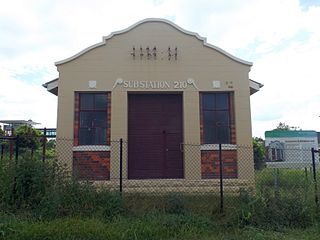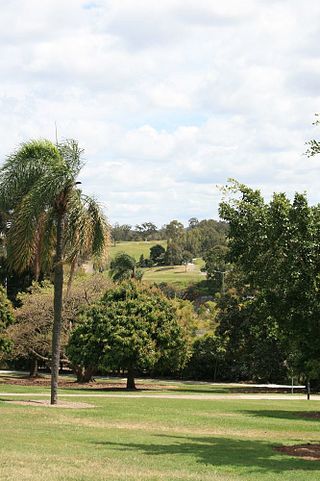
Brisbane Powerhouse is an arts and cultural hub located in a former power station in the Brisbane suburb of New Farm, Queensland, Australia. The venue offers an array of performing arts, visual arts, festivals, and free community events.

Paddington is an inner suburb in the City of Brisbane, Queensland, Australia. In the 2016 census, Paddington had a population of 8,562 people.

The Brisbane tramway network served the city of Brisbane, Australia, between 1885 and 1969. It ran on standard gauge track. The electric system was originally energised to 500 volts, and subsequently increased to 600 volts. All tramcars built in Brisbane up to 1938 had an open design. This proved so popular, especially on hot summer nights, that the trams were used as fundraisers and often chartered right up until the last service by social groups.

Mount Crosby pumping station is a heritage-listed pumping station and weir at Stumers Road, Mount Crosby, City of Brisbane, Queensland, Australia. It is located on the Brisbane River and extends into Chuwar on the other side of the river. The facility supplies water to Brisbane and nearby cities and towns within the SEQ Water Grid. It was originally designed by Charles H McLay and built from 1891 to 1892. The historic parts of the facility were added to the Queensland Heritage Register on 25 October 2019. It is also listed on the Brisbane Heritage Register, together with numerous associated facilities which were not included in the state heritage listing.

The provision of electricity in Queensland required a considerable degree of pioneering, innovation, and commitment. Queensland proved to be a pioneer in the supply of electricity in Australia, with the first public demonstration in Australia, the first recorded use for public purposes in the country, the first Parliament House in Australia and the first commercial operations in Australia all occurring in Brisbane.

Newtown Tram Depot is a heritage-listed former tram depot in King Street, Newtown, City of Sydney, New South Wales, Australia. It was part of the Sydney tram network. The tram depot and Newtown railway station were jointly added to the New South Wales State Heritage Register on 2 April 1999.

Windsor Town Quarry Park and Tramways Substation No. 6 is a heritage-listed former quarry with electrical substation at 356 Lutwyche Road, Windsor in the City of Brisbane, Queensland, Australia. It was built from c. 1926 to c. 1928. The park and substation were added to the Queensland Heritage Register on 31 May 2005. There is another, larger substation building, Tramways Substation No. 13 which was designed by Frank Gibson Costello and became operational in June 1949.

Brisbane City Council Tramways Substation No. 9 is a heritage-listed electrical substation at 97 Wynnum Road, Norman Park, Queensland, Australia. It was built in 1935. It was added to the Queensland Heritage Register on 5 August 2003.

Coorparoo Substation No. 210 is a heritage-listed electrical substation at 12 Main Avenue, Coorparoo, City of Brisbane, Queensland, Australia. It was designed by Reyburn Jameson and built in 1930 by A. Mason. It is also known as Substation 10. It was added to the Queensland Heritage Register on 1 August 2005.

Old Cleveland Road Tramway Tracks is a heritage-listed tramway along Old Cleveland Road in Camp Hill and Carina, adjoining suburbs in the City of Brisbane, Queensland, Australia. It was built in 1948 by Brisbane City Council. It is also known as Belmont Electric Tramway. It was added to the Queensland Heritage Register on 24 March 2000.

Sandgate Post Office is a heritage-listed former post office at 1 Bowser Parade, Sandgate, City of Brisbane, Queensland, Australia. It was designed in the office of the Queensland Colonial Architect and built from 1886 to 1887. It is also known as Sandgate Post and Telegraph Office. It was added to the Queensland Heritage Register on 7 February 2005.

Victoria Park, increasingly known by its Turrbal name of Barrambin, is a heritage-listed park located in Spring Hill and Herston in Brisbane, Australia. It was added to the Queensland Heritage Register on 3 December 2007. The site was formerly a public golf course that opened in November 1931, before it was converted back to a park in June 2021 as part of redevelopment works.

Paddington Tramways Substation is a heritage-listed former electrical substation at 150 Enoggera Terrace, Paddington, City of Brisbane, Queensland, Australia. It was designed by Roy Rusden Ogg and built from 1929 to 1930. It was added to the Queensland Heritage Register on 22 March 1993.
The electricity supply in Brisbane has been an important part of the economic and social development of the city of Brisbane, Queensland, Australia.
A network of Brisbane tramways substations, supplied from the Brisbane Powerhouse, were developed by Brisbane City Council after they took over the Brisbane Tramways system from Brisbane Tramways Company (BTCo). The new powerhouse and substations were needed, as BTCo had not adequately invested enough into the electricity network to keep the system running efficiently. Brisbane City Council maintained this electricity network from 1927 until 1969, when the decision was made not to have Trams in Brisbane, and the network was shut down and decommissioned.

Electricity Substation No. 167 is a heritage-listed electrical substation at 93 Parramatta Road, Auburn, Cumberland Council, New South Wales, Australia. It was designed and built from 1924 to 1929 by the Municipal Council of Sydney, with the City Architect being responsible for the design. It is also known as #167 'AUBURN' 33KV ZONE SUBSTATION. The property is owned by Ausgrid. It was added to the New South Wales State Heritage Register on 2 May 2008.

Electricity Substation No. 269 is a heritage-listed electrical substation located at 36 Anglesea Street, Bondi, Waverley Municipality, New South Wales, Australia. It was designed by Walter Frederick White, City Architect's Office and Municipal Council of Sydney and built in 1928 by the Municipal Council of Sydney. It is also known as #269 'WAVERLEY' 33KV ZONE, ELECTRICITY DEPT SUBSTATION No. 269, Angelsea Sub Station and Waverley Zone Substation. The property is owned by Ausgrid, an agency of the Government of New South Wales. It was added to the New South Wales State Heritage Register on 2 May 2008.

The Electricity Substation No. 349 is a heritage-listed electrical substation at 2S Frances Street, Randwick, City of Randwick, New South Wales, Australia. It was designed by Walter Frederick White, City Architect's Department and Municipal Council of Sydney and built during 1930 by J Rutherford. It is also known as #349 Princes Street substation. The property is owned by Ausgrid, an agency of the Government of New South Wales. It was added to the New South Wales State Heritage Register on 2 May 2008.

Taylor Square Substation No.6 and Underground Conveniences is a heritage-listed electrical substation and underground public toilets at the intersection of Taylor Square, Oxford, Forbes and Bourke Streets, in the inner city Sydney suburb of Darlinghurst in the City of Sydney local government area of New South Wales, Australia. Both the substation and the underground conveniences were designed by Robert Hargreave Brodrick and built from 1904 to 1907, with Owen Ridge & Sons building the substation and G. D. Getherson the underground public conveniences. The property is owned by City of Sydney. It was added to the New South Wales State Heritage Register on 2 July 2004.
Endrim, Woodstock Road tram shed, and tram track are a heritage-listed group consisting of a house, a tramway and a tramway stop at 6 & 28 Woodstock Road, Toowong, City of Brisbane, Queensland, Australia. They were built in 1906 by the Brisbane Tramways Company Limited. Endrim is also known as Arlington and "Boss" Badger's residence. It was added to the Queensland Heritage Register on 23 March 2018.




















